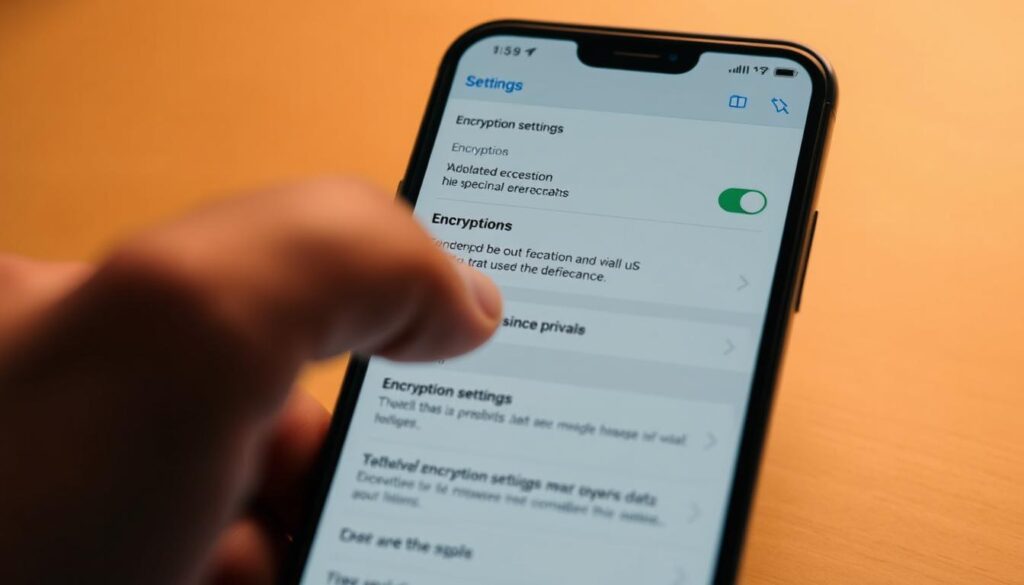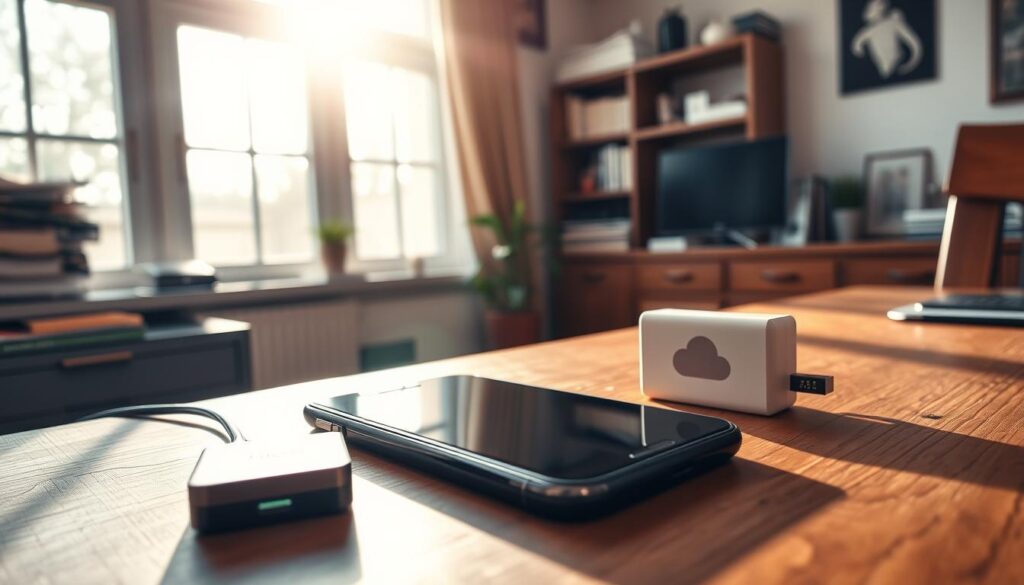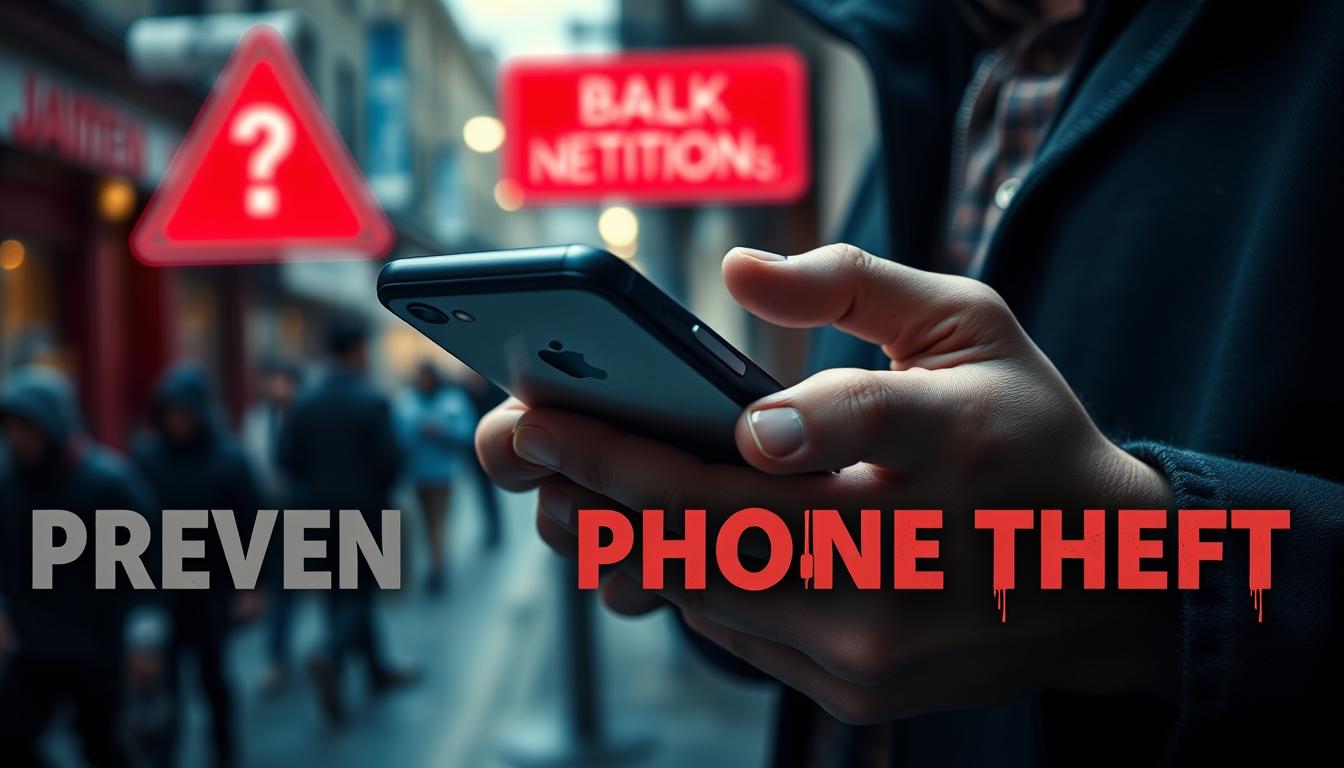Phone theft is on the rise, making smartphones a prime target for criminals. They steal devices to sell them or to hack into bank apps, emails, and social media. In UK cities, over 40% of thefts lead to identity fraud, making protection crucial.
Contents
- 1 Understanding the Mobile Theft Epidemic
- 2 Keep Your Phone Out of Sight in Public Places
- 3 Securing Your Device with Proper Authentication
- 4 Protecting Your Digital Identity
- 5 Be Mindful of Your Surroundings When Using Your Phone
- 6 Essential Phone Settings That Deter Thieves
- 7 Phone Theft On The RISE!!! What the Statistics Tell Us
- 8 Recovery Tools and Techniques You Need to Know
- 9 Back Up Your Phone Regularly to Minimize Data Loss
- 10 Location-Specific Prevention Strategies
- 11 Insurance Options and Reporting Procedures
- 12 Conclusion: Staying One Step Ahead of Phone Thieves
- 13 FAQ
- 13.1 How can I secure my mobile bank app to prevent unauthorized access?
- 13.2 What are some effective mobile security tips to protect my personal details?
- 13.3 How can I track my phone if it’s lost or stolen?
- 13.4 What should I do if my phone is stolen in London?
- 13.5 Why is phone theft up 40%, and what does that mean for me?
- 13.6 What should I back up on my phone to minimize data loss?
Key Takeaways
- Use Find My iPhone or Google Find My Device to locate stolen phones instantly.
- Biometric locks like fingerprint scanners block unauthorized access instantly.
- Two-factor authentication adds a second layer to banking and email apps.
- Remote wipe features erase data if your device gets stolen.
- Public transport and crowded areas need extra vigilance to avoid theft.
Understanding the Mobile Theft Epidemic
Phone theft has skyrocketed by 40% in the UK. This isn’t just about losing phones. It’s a doorway to identity fraud and financial loss. Let’s explore why this is a big deal and how thieves work.
Why Phone Theft Up 40% Is a Serious Concern
The demand for smartphones drives theft. But the real danger is in stolen data. Thieves quickly sell devices, often removing parts or wiping data. Yet, 40% of victims report identity theft linked to their stolen phones, showing risks beyond just losing a device.
How Thieves Target Both Your Device and Personal Information
- Resell stolen devices through online marketplaces.
- Access bank apps using weak passwords or stolen fingerprints.
- Use cloned SIM cards to intercept verification codes.
Common Theft Scenarios You Should Know About
Thieves act quickly in crowded places. Here’s how they operate:
- Snatch-and-Grab: Opportunistic thieves snatch phones from hands or bags in busy streets.
- Distraction Tactics: Fake collisions or dropped items to divert attention while phones are stolen.
- Transport Hotspots: Trains and buses see frequent thefts—thieves exploit packed spaces to slip unnoticed.
“Over 50% of reported thefts occur in urban centers like London.”
Keep Your Phone Out of Sight in Public Places
Thieves look for shiny devices in busy areas. Simple mobile security tips can help you avoid being a target. Keep your phone in inner pockets or bags. Never leave it out on tables or laps.
- Choose plain, matte phone cases instead of flashy designs.
- Lower screen brightness in public to reduce glare attracting attention.
- Use headsets to take calls hands-free, avoiding lengthy public screen use.
A 2023 study by the UK’s City Safety Council found 68% of thefts occurred when devices were in open view. When commuting, keep phones face-down in bags. At events, avoid pulling out high-end models during crowded moments. Even quick glances at screens can alert passersby to your device’s value.
“Thieves prioritize easy targets. Staying inconspicuous reduces your risk by 40%,” says cybersecurity expert Sarah Mitchell of London’s Digital Security Hub.
Adapt these mobile security tips to daily routines: shop for low-profile accessories, practice mindful phone handling, and prioritize stealth in high-traffic zones. Small changes make a big difference in deterring unwanted attention.
Securing Your Device with Proper Authentication
Protecting your phone starts with strong authentication methods. Weak PINs or reused passwords leave your data vulnerable. Follow these steps to secure your personal details effectively:
- Avoid birthdates or simple patterns like 1234
- Use 6-digit codes instead of 4-digit PINs
- Enable emergency SOS lock for extra protection
Maximize biometric tools:
Modern devices offer fingerprint scanners and facial recognition. Clean sensors regularly and avoid registering multiple fingerprints unless necessary. Remember: biometrics alone aren’t foolproof—always pair with passcodes.
Enable two-factor authentication (2FA):
Banking apps like Monzo and email services such as Gmail require 2FA setup. This adds a verification step, making unauthorized access nearly impossible even if passwords are compromised.
“Biometric systems reduce 80% of casual theft risks when combined with PINs,” says the UK’s National Cyber Security Centre.
Update authentication methods regularly and never share backup codes. These layers form a barrier against identity theft and financial fraud. Simple steps today prevent major headaches later.
Protecting Your Digital Identity
Start by securing every point where hackers might try to get in. This includes your mobile bank app, personal data, and social media. Here’s how to keep your online presence safe.
- Enable two-factor authentication for banking apps like Barclays, HSBC, or NatWest.
- Set transaction limits via your bank’s app settings to block large unauthorized transfers.
- Turn on login notifications so you’re alerted whenever someone tries to access your account.
- Avoid saving payment details in unsecured wallets; use encrypted apps like Google Pay or Apple Pay instead.
Safeguarding Personal Details on Your Phone
Don’t store sensitive info like passport numbers or passwords in basic notes apps. Instead:
- Use password managers like 1Password or LastPass to encrypt stored data.
- Regularly review app permissions in Settings to revoke access for unused apps.
Managing Social Media Privacy Settings
“Public posts about travel plans or home addresses create goldmines for identity thieves.” – CyberUK Security Advisory
Change your privacy settings to “Friends Only” on sites like Facebook and Instagram. Avoid:
- Checking in real-time at locations
- Tagging children or family members
- Using public Wi-Fi to access banking or social media
Check app permissions every month and turn off location sharing for apps you don’t need. Taking small steps now can save you big trouble later.
Be Mindful of Your Surroundings When Using Your Phone
Smartphone thieves act quickly, often in busy places where people are distracted. Simple mobile security tips can prevent most thefts. Always check your surroundings before using your phone. Look for exits and stay away from corners where strangers can surprise you.
“Thieves target those who seem unaware. Stay alert and keep your device close—like a wallet.” – London Anti-Street Crime Unit
- Hold the phone in hand, not in a bag or pocket, when passing through crowds
- Shorten calls/texts in transit to reduce visible screen time
- Avoid using phones while walking backward—keep moving forward with eyes up
Use the “defensive hold” method: hold your phone in your palm to make it harder to grab. Thieves usually target people who face away from them. In places like London Tube stations, always have one hand ready to hold onto your belongings. These habits will become second nature with practice, helping you stay safe in crowded areas.
Essential Phone Settings That Deter Thieves
Changing a few settings on your phone can really help keep thieves away. These three features are like digital shields for your data. They turn your device into a strong fortress.
Configuring Auto-Lock and Screen Timeout Features
Auto-lock stops strangers from seeing your screen when you’re not there. Set screens to lock within 30 seconds in Settings > Display & Brightness for iPhones or Settings > Security > Screen timeout on Android. This shortens the time thieves have to access your phone.

Setting Up Remote Wipe Capabilities
- iOS: Enable Find My iPhone under iCloud settings to erase data remotely.
- Android: Use Find My Device by Google to locate or erase your phone from a browser.
These tools help you wipe all data if your phone is lost. This means thieves can’t get to your contacts, messages, or apps.
Using Encryption to Protect Sensitive Data
Encryption makes your data unreadable to anyone who doesn’t have permission. Turn on full-disk encryption in Settings > Security on Android or Settings > Passcode Lock on iPhones. Also, use apps like Signal or WhatsApp for encrypted messages. As tech expert Sarah Lin said in a 2023 report: “Encryption makes stolen data unreadable to others.”
These steps only take a few minutes but add a lot of protection. Secure your personal details by making these settings a regular part of your routine. It’s easier and cheaper to prevent problems than to fix them later.
Phone Theft On The RISE!!! What the Statistics Tell Us
Recent data shows phone theft on the rise in the UK. There’s been a 40% increase in thefts over the last year. Police records and insurance claims point to a worrying trend, especially in cities.
- London accounts for 28% of reported thefts, followed by Manchester and Birmingham.
- Most thefts happen between 6 PM and midnight, with places like train stations being hotspots.
- Flagship models like iPhone 15 and Samsung Galaxy S24 are stolen twice as often as budget devices.
“Smartphone thefts now cost victims an average of £1,200 annually in replacement costs and data recovery.” – National Police Chiefs’ Council Report 2023
Thieves target valuable devices in crowded places. The resale market for stolen phones is booming online. This includes secondhand platforms and dark web sites. It’s alarming that 60% of victims lose personal data too.
To stay safe, use tips from earlier sections. This includes securing biometrics and using tracking apps. Knowing these patterns helps you stay one step ahead of thieves.
Recovery Tools and Techniques You Need to Know
When your phone goes missing, recovery tools can turn the tables on thieves. Features like Find My Phone apps are your first line of defense. Enable these tools now to stay prepared—don’t wait until it’s too late.
How to Use Find My Phone Features Effectively
Apple’s Find My iPhone and Google’s Find My Device let you track, lock, or erase your phone remotely. Here’s how:
- Open the find my phone app on another device.
- Tap “Devices” to see your phone’s real-time location on a map.
- Use “Play Sound” to locate it nearby or “Lost Mode” to lock access with a passcode.
Tracking Apps That Help Locate Stolen Devices
Third-party apps add extra layers of protection. Here are some options:
| App Name | Features | Price | Platforms |
|---|---|---|---|
| Prey | Remote lock, photo capture, GPS tracking | Free/Paid tiers | Android & iOS |
| Cerberus | Call recording, SMS monitoring, screen capture | Free/Premium | Android |
| Lookout | Antivirus integration, location history | Free | Android & iOS |
Working with Authorities to Recover Your Phone
Contact your carrier to block the stolen device immediately. Give police:
- IMEI number (found under Settings > About Phone)
- Last known location from tracking data
- Recent photos or videos showing the theft
Authorities often use IMEI databases to identify stolen devices—keep records of your device details in a safe place.
Back Up Your Phone Regularly to Minimize Data Loss
Even with top security, phones can still get stolen. Backing up your data is key to protect your memories and files. Regular backups keep your photos, contacts, and apps safe, no matter what happens to your phone.
Choose a backup method that suits you. You can use:
- Cloud services like iCloud, Google Drive, or OneDrive
- Computer backups via USB to an external drive
- Third-party apps like MyBackup Pro or Helium
Make it automatic to avoid forgetting. For iOS, turn on iCloud Backup in Settings > [Your Name] > iCloud > iCloud Backup. For Android, go to Settings > System > Backup > Google Backup. Set it to run daily or weekly, depending on how often you update your phone.
“A stolen phone is a data emergency—but backups turn panic into a quick recovery,” says tech security expert Sarah Mitchell.
Encrypt your backups and use two-factor authentication for cloud accounts. If you store sensitive info, ensure backup services meet UK data protection standards. Most people back up monthly, but daily backups are best for those who use their phones a lot.

Think of it as digital insurance. A few minutes setting up automated backups today could save hours of stress later. Your photos, messages, and apps will be recoverable in minutes, not lost forever. Make backups a habit—your future self will thank you.
Location-Specific Prevention Strategies
London and major UK cities face unique challenges with phone theft in London. Crowded streets, transit systems, and lively nightlife offer thieves opportunities. Here’s how to stay safe in these risky places.
Addressing Phone Theft in London and Major UK Cities
Places like Covent Garden, Camden Market, and Oxford Street are pickpocket hotspots. Thieves often target tourists and people who are distracted. Always hide your devices in inner pockets or secure bags. Don’t show off expensive gadgets.
Special Precautions for Public Transport
On the London Underground and buses, keep phones in sight but close to your body. Use anti-theft backpacks with lockable zippers. Don’t charge devices in crowded stations—thieves might knock them off tables.
- Tube lines: Stay alert on platforms and escalators.
- Buses: Keep phones in front pockets while seated.
- Trains: Secure devices during peak hours.
Nightlife and Entertainment Venue Safety
Clubs and concerts are prime spots for theft. Follow these rules:
| Location | Risk Factors | Safety Tips |
|---|---|---|
| Bars | Overcrowding, dim lighting | Leave phones in coat check or with a buddy |
| Music Festivals | Long queues, bag checks | Use wrist straps or hidden pockets |
| Railway Stations | Rush hour congestion | Carry phones in anti-theft cases |
Data shows phone theft in London increases by 20% near major attractions. Stay alert—your awareness is your best defense.
Insurance Options and Reporting Procedures
Protecting your phone is more than just physical measures. mobile security tips also include picking the right insurance. Look at these plans to find one that suits you:
- Carrier Insurance: UK providers like EE or O2 offer theft replacement plans with contracts.
- Manufacturer Plans: Brands such as Apple or Samsung provide extended coverage for accidental damage.
- Third-Party Policies: Compare premiums from insurers like Aviva or Comparethemarket for customizable options.
| Plan Type | Coverage | Cost Notes |
|---|---|---|
| Carrier Insurance | Device replacement after theft | Typically included in monthly bills |
| Manufacturer Plans | Damage and theft coverage | Additional fees apply |
| Third-Party | Customizable terms | Premiums vary by provider |
If your phone gets stolen, act fast:
- Contact your insurer within 24 hours for claims guidance.
- Provide police report details and device IMEI numbers.
- Use backup data recovery tools while awaiting replacement.
“Documentation like purchase receipts and insurance policies are critical during claims,” advises Which? magazine.
Regularly check your coverage terms. Make sure policies match your usage habits. These steps make insurance a key part of your mobile security tips strategy.
Conclusion: Staying One Step Ahead of Phone Thieves
Phone theft is becoming more common, so it’s crucial to take steps to protect your device and data. Start by turning on auto-lock and remote wipe to block thieves. Use strong passwords, biometrics, and two-factor authentication to keep them out.
Regular backups are also key. They help keep your photos and files safe, even if your phone is stolen.
In busy UK cities like London, be extra careful with your phone. Always keep it hidden in crowded places and avoid using it on public transport. Tools like Find My Device or Samsung Find My Mobile can help find your stolen phone. Insurance policies can also help reduce financial loss.
Staying ahead of phone thieves means adapting to new threats. Enable encryption, update apps, and check your privacy settings every month. Small steps like setting up emergency contacts or using secure networks can make a big difference. By using technology and staying informed, you can protect your digital life.
FAQ
What are some effective mobile security tips to protect my personal details?
How can I track my phone if it’s lost or stolen?
What should I do if my phone is stolen in London?
Why is phone theft up 40%, and what does that mean for me?
What should I back up on my phone to minimize data loss?

Joe Wright is a finance expert, blogger, and author from New York. He recently graduated in finance and writes about loans, credit cards, and money management. Joe helps people understand finance and make smart financial decisions.

